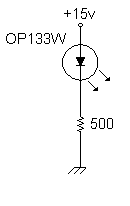
Magnetic Levitation
Levitation
- Introduction
- Why
- Other Maglev
- Hard Drive Maglev
- Schematic
- Parts List
- Buying Parts
- Woodworking
- Other's
- Photographs
- Infrared Emitter
- Photodetector
- Reference Det
- Difference Amp
- Feedback Loop
- Loop Equations
- Bode Plot
- Phase Lead
- Output Amp
- Coil Driver
- PWM
- Lifting Coil
- PSPICE
- Build Time
- PCB
- Power Supplies
- Setup
- Test Power
- Test IR Emitter
- Test Signal Det
- Test Ref Det
- Adjust Sensing Res
- Test Diff Amp
- Test Non-Invert Amp
- Test Coil Driver
- Test Lifting Coil
- Results
Testing the Infrared Emitter
The infrared LED generates invisible light, so how can you tell if it's working? To read about the design of this little circuit go here.
See If Emitter Is Working
Follow these steps to take voltage and current measurements to check the LED operation.

- Measure the voltage on the LED pins. Since this is a forward-biased diode, it should be a little under 1 volt.
- If the measurement is the same as the power supply, you have a problem. It is most likely connected backwards. This doesn't damage the LED, so just reverse its connection and try again.
- If the measurement is zero volts, then you have a wiring problem. There is most likely an open connection somewhere.
- Is the 500-ohm resistor warm? Careful! This resistor can burn you! It is normal in this circuit for the resistor to run fairly warm.
- Is the 500-ohm resistor very hot? It should be warm, but not too hot to touch. If so replace it with a higher-wattage resistor, or use two 1-kilohm resistors in parallel.
- The physical position and focusing (if any) should cause equal amounts of light to fall on the optodetectors. This makes a better comparison between their two electrical signals. If you have a visible-light LED then adjust it for good coverage. If it is infrared, then take your best guess.
- Secure the LED in place so it cannot move. The detectors are very sensitive and will fall out of adjustment if the LED is bumped or replaced.
Note: The 500-ohm resistor might be replaced in a later step during checkout. But you won't know if your LED is bright enough until after you test the optodetectors.
| < Previous | Page 29 of 37 | Next > |
Last Update 2008-06-08
©1998-2024 Barry Hansen
©1998-2024 Barry Hansen